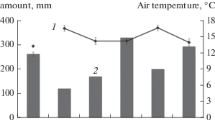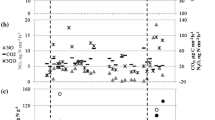Abstract
Many of the environmental problems related to agriculture will still be serious over the next 30 years. However, the seriousness of some of those problems may increase more slowly than in the past or even diminish in other cases (FAO 2002). Agriculture plays two different roles in climate change; on one hand, it suffers from the impact of climate change, on the other hand, it is responsible for 14 % of total greenhouse gases (MMA 2008). Nevertheless, agriculture is also part of the solution, as it is capable of mitigating a significant amount of global emissions, according to the FAO (2001). This paper aims to study the influence of edapho-climate conditions on soil CO2 emissions into the atmosphere. In order to do so, we conducted three field trials in different areas in southern Spain, which have different soil textures and different climate conditions. The results show how interaction between the temperature and rainfall recorded has a greater influence on emissions than each of the factors separately. However, at the same time, the texture of the soil at each of the locations was also found to be the most dominant variable in the gas emission process.




Similar content being viewed by others
References
Aguilera, S.M. (2000). Importancia de la protección de la materia orgánica en suelos. Simposio Proyecto Ley Protección de Suelo. Boletín No. 14. Valdivia, pp. 77–85.
Álvaro, J., López, M. V., García, R., & Arrúe, J. L. (2004). Effect of tillage on short-term CO2 emissions from a loam soil in semiarid Aragon (NE Spain). In: Arrúe, J.L., Cantero-Martínez, C. Third Mediterranean meeting on no tillage. Options Mediterranées, 60, 51–54.
Álvaro-Fuentes, J., Cantero-Martínez, R., & Arrúe, J. L. (2007). Soil carbon dioxide flux following tillage in semiarid Mediterranean agroecosystems. Soil & Tillage Research, 96, 331–341.
Álvaro-Fuentes, J., López, M. V., Arrúe, J. L., & Cantero-Martínez, C. (2008). Management effects on soil carbon dioxide fluxes under semiarid Mediterranean conditions. Soil Science Society of America Journal, 72, 194–200.
Amato, M., & Ladd, J. N. (1992). Decomposition of 14C-labelled glucose and legume material in soils: Properties influencing the accumulation of organic residue C and microbial biomass C. Soil Biology and Biochemistry, 24, 455–464.
Arrigo, N. M., Jiménez, M. P., Effron, D., & Defrieri, R. (2002). Carbono de respiración de un suelo forestal y su relación con la calidad de la hojarasca. Agricultura Técnica, 62(2), 331–338.
Caravaca, F., Lax, A., & Albadalejo, J. (2001). Soil aggregate stability and organic matter in clay and fine silt fractions in urban refuse-amended semiarid soils. Soil Science Society of America Journal, 65, 1235–1238.
Carbonell, R. (2009). Efecto de la aplicación de enmiendas orgánicas y del manejo del suelo sobre el papel de la Agricultura en los procesos de fijación y emisión de carbono. Tesis Doctoral. Universidad de Córdoba, Cordoba.
Casals, P., Romanyà, J., Cortina, J., Bottner, P., Coûteaux, M. M., & Vallejo, V. R. (2000). CO2 efflux from a Mediterranean semi-arid forest soil. I. Seasonality and effects of stoniness. Biogeochemistry, 48, 261–281.
Chaney, K., & Swift, R. S. (1984). The influence of organic matter on aggregate stability in some British soils. Journal of Soil Science, 35, 223–230.
Claassen, R., & Morehart, M. (2009). Agricultural land tenure and carbon offsets. Economic Brief-14. Department of Agriculture, Economic Research Service, Washington.
Davis, J. C. (1993). Statistic and data analysis in geology. New York: Wiley.
Delaney, M. T., Fernández, I. J., Simmons, J. A., & Briggs, R. D. (1996). Red maple and white pine litter quality: Initial changes with decomposition. Maine Agricultural and Forest Experiment Station Technical Bulletin, 162, 1–19.
Dolan, M. S., Clapp, C. E., Allmaras, R. R., Baker, J. M., & Molina, J. A. E. (2006). Soil organic carbon and nitrogen in a Minnesota soil as related to tillage, residue and nitrogen management. Soil & Tillage Research, 89, 221–231.
Emmet, B. A., Beier, B., Estiarte, M., Tietema, A., Kristensen, H. L., Williams, D., et al. (2004). The response of soil processes to climate change: Results from manipulation studies of shrublands across an environmental gradient. Ecosystems, 7, 625–637.
Etchevers, J. D., Prat, C., Balbontín, C., Bravo, M., & Martínez, M. (2006). Influence of land use on carbon sequestration and erosion ion Mexico: A review. Agronomy for Sustainable Development, 26, 21–28.
FAO. (2001). Soil carbon sequestration for improved land management. Based on the work of Michel Robert. Paris: Institut National de Recherché Agronomique.
FAO. (2002). Agricultura Mundial: hacia los años 2015/2030. Rome: Informe Resumido.
Figueroa, M. A., & Redondo, S. (2007). Los sumideros naturales de CO 2 . Una estrategia sostenible entre el Cambio Climático y el Protocolo de Kyoto desde las perspectivas urbana y territorial (p. 221). Seville: Universidad de Sevilla.
Gregorich, E. G., Voroney, R. P., & Kachanoski, R. G. (1991). Turnover of carbon through the microbial biomass in soil with different textures. Soil Biology and Biochemistry, 23, 799–805.
Grundmann, G. L., Renault, P., Rosso, L., & Bardin, R. (1995). Differential effect of soil water content and temperature on nitrification and aireation. Soil Science Society of America Journal, 59, 1342–1349.
Jenkinson, D. S. (1992). La materia orgánica del suelo: evolución. In A. Wild (Ed.), Condiciones del suelo y desarrollo de las plantas. Madrid: Mundi-Prensa.
Knoepp, J. D., & Swank, W. T. (2002). Using soil temperature and moisture to predict forest soil mineralization. Biology and Fertility of Soils, 36, 177–182.
Kononova, M. M. (1975). Humus of virgin and cultivated soils. In J. E. Gieseking (Ed.), Soil components (Vol. 1, pp. 475–526). New York: Springer.
Kowalenko, C., Ivarson, K., & Cameron, D. (1978). Effect of moisture content, temperature and nitrogen fertilization on carbon dioxide evolution from field soils. Soil Biology and Biochemistry, 10, 417–423.
Lacasta, C., Benítez, M., Maire, N., & Meco, R. (2006). Efecto de la textura del suelo sobre diferentes parámetros bioquímicas. VII Congreso SEAE: Agricultura y alimentación ecológica. Trabajo 110.
Ladd, J. N., Oades, J. M., & Amato, M. (1981). Microbial biomass formed from 14C- and 15N-labelled plant material decomposing in soil in the field. Soil Biology and Biochemistry, 13, 119–126.
Ladd, J. N., Amato, M., & Oades, J. M. (1985). Decomposition of plant material in Australian soil III. Residual organic and microbial biomass C and N from isotope-labelled legume material and soil organic matter, decomposing under field conditions. Australian Journal of Soil Research, 22, 331–341.
MMA. (2008). Ministerio de Agricultura, Medio Ambiente y Marino. Anuario de Estadísticas.
Nelson, D. W., & Sommer, L. E. (1982). Total carbon, organic carbon and organic matter. In R. H. Page & D. R. Keeny (Eds.), Methods of soil analysis, II. Chemical and microbiological properties (2nd ed.). Madison: Soil Science Society of America.
Ordóñez, R., Carbonell, R., González, P., & Perea, F. (2008). Influencia de la climatología y el manejo del suelo en las emisiones de CO2 en un suelo arcilloso de la Vega de Carmona. CAREL, VI, 229–247.
Perea, F. (2000). Agronomía del laboreo de conservación en los vertisoles de la campiña andaluza. Tesis Doctoral. Universidad de Córdoba. Departamento de Agronomía, Cordova.
Quemada, M., & Cabrera, M. L. (1997). Nitrogen released from cover residues under non-till conditions: Evaluating the CERES-N submodel. Agronomy Journal, 89, 723–729.
Reicosky, D. C. (2002). Long-term effect of moldboard plowing on tillage-induced CO2 loss. In J. M. Kimble, R. Lal, & R. F. Follet (Eds.), Agricultural practices and polices for carbon sequestration in soil. Papers form symposium held July 1999 at Ohio State University (pp. 87–96). Columbus: Lewis Publishers.
Reicosky, D. C., & Archer, D. W. (2007). Mouldboard plow tillage depth and short-term carbon dioxide release. Soil & Tillage Research, 94, 109–121.
Rothon, F. E. (2000). Influence of time on soil response to no-till practices. Soil Science Society of America Journal, 64, 700–709.
Schlesinger, M. E. (Ed.). (1991). Greenhouse-gas-induced climatic change: A critical appraisal of simulations and observations (p. 615). Amsterdam: Elsevier.
Scott, N., Cole, C., Elliott, E. T., & Huffman, S. (1996). Soil textural control on decomposition and soil organic matter dynamics. Soil Science Society of America Journal, 60, 1102–1109.
Shine, K. P., & Forster, P. M. D. (1999). The effect of human activity on radiative forcing of climate change: A review of recent developments. Global and Planetary Change, 20, 205–225.
Sigman, D. M., & Boyle, E. A. (2000). Glacial/interglacial variations in atmospheric carbon dioxide. Nature, 401, 859–869.
Skjemstad, J. O., Janik, L. J., Head, M. J., & McClure, S. G. (1993). High energy ultraviolet photo-oxidation: A novel technique for studying physically protected organic matter in clay and silt-sized aggregates. Journal of Soil Science, 44, 485–499.
Smith, P., Martino, D., Cai, Z., Gwary, D., Janzen, H., Kumar, P., et al. (2007). Agriculture. In B. Metz, O. R. Davidson, P. R. Bosch, R. Dave, & L. A. Meyer (Eds.), Climate change 2007: Mitigation (Contribution of Working Group III to the Fourth Assessment Report of the Intergovernamental Panel on Climate Change). Cambridge: Cambridge University Press.
SoCo Project Team. (2009). Addressing soil degradation in EU agriculture: Relevant processes, practices and policies. Report on the Project “Sustainable Agriculture and Soil Conservation (SoCo). European Commission. Join Research Centre. Institute for Prospective Technological Studies.
Soil Survey Staff. (1999). Soil taxonomy. A basic system of soil classification for making and interpreting soil surveys (2nd ed.). Washington: USDA.
Swift, R. S. (2001). Sequestration of carbon by soil. Soil Science, 166, 858–871.
Swift, M. J., Heal, O. W., & Anderson, J. M. (1979). Decomposition in terrestrial ecosystems, studies in ecology 5. London: Blackwell Scientific Publications. 323.
Theng, B., Churchman, G., & Newman, R. (1986). The occurrence of interlayer clay-organic complexes in two New Zealand soils. Soil Science, 142, 262–266.
Acknowledgements
The authors would like to thank the project LIFE+AGRICARBON: Sustainable Agriculture in Carbon Arithmetics (LIFE08 ENV/E/000129) for its financial support [LIFE (LIFE08 ENV/E/000129 AGRICARBON)].
Author information
Authors and Affiliations
Corresponding author
Rights and permissions
About this article
Cite this article
Carbonell-Bojollo, R.M., Repullo-Ruibérriz de Torres, M.A., Rodríguez-Lizana, A. et al. Influence of Soil and Climate Conditions on CO2 Emissions from Agricultural Soils. Water Air Soil Pollut 223, 3425–3435 (2012). https://doi.org/10.1007/s11270-012-1121-9
Received:
Accepted:
Published:
Issue Date:
DOI: https://doi.org/10.1007/s11270-012-1121-9




